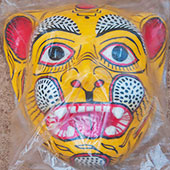Design Resource
Papier Mache Mask - Raghurajpur, Orissa
Crunched Paper Art
by
Prof. Bibhudutta Baral, Divyadarshan C. S. and Aakash Sharma
The traditional layered Paper Mache process is done with the help of new paper. Mache clay and even newer silky-smooth air-dry clay is used for most of the masks. White flour, tamarind seed’s powder and water make a remarkably strong paste after its boiled, the mask is got back to cool temperature. Which helps in sticking the paper across the mold.
This paste is not as strong as raw paste and so, artesian need more layers of paper to make their finished sculpture stiff enough. However, it does dry clear, so many people prefer to use the homemade paste. To make boiled paste, artesian mixes a tablespoon of white flour, tamarind seed’s powder with a cup of water in a small saucepan and stir until there are no lumps. Pan is kept on the stove at medium heat temperature and bought to a boil, stirring constantly. Later it’s removed from heat and allowed to cool down. The paste will be very soft at this stage, but it will gel as it cools. The paste is stronger once boiled which gives strength to the paper Mache mask that must dry completely to keep it from developing mold.
Artisan dries out the water completely. The main trick is to make sure the mask is dry all the way through – if any dampness is left inside when paint is applied, the mask will eventually rot from the inside out. The traditional paper to use for Paper Mache is newspaper, which is torn into short strips. Newspaper is cheap in cost, soft material that’s easy to bend and mold around a mask. However, artisans also use brown paper from paper boxes, which will give strength to the mask as a base. The softer papers are used to fashion delicate details, and textured paper cloths can be used to add an interesting final coat.
Artesian apply a coat of white paint, sand it out and then add another layer if the surface still isn’t smooth enough. Artesian use paints like acrylic, enamel with and the final glaze is made from water-based varnish which contains a shade of brown. These masks are pierced from sides and a thread is added to tie the mask on the face. This final coat is put on with a brush with some details of the craft targeting the required audience. These masks would vary from INR.200 to INR.400.































